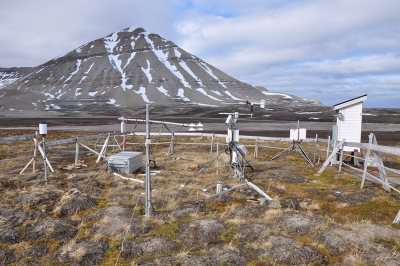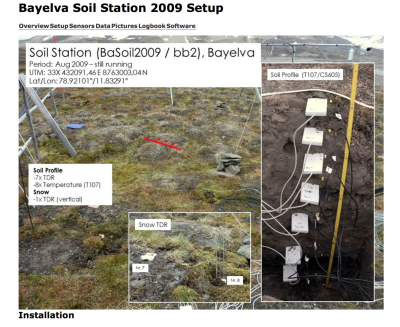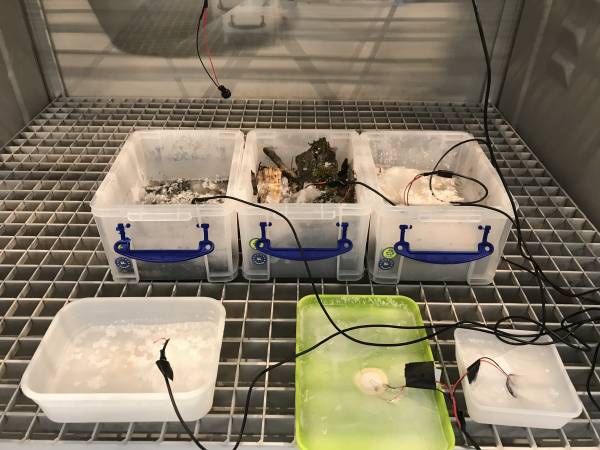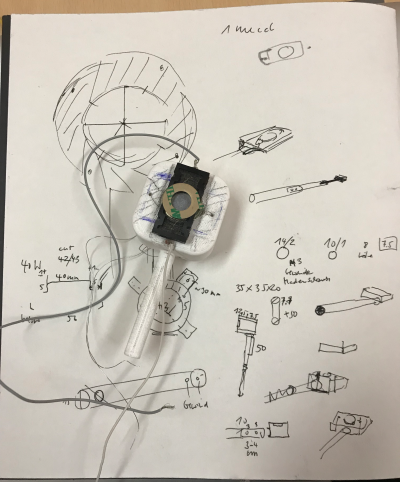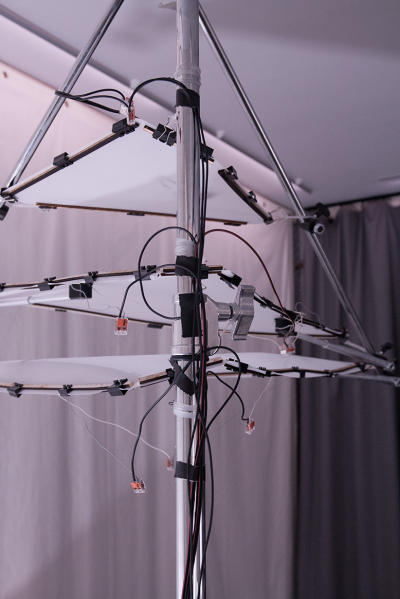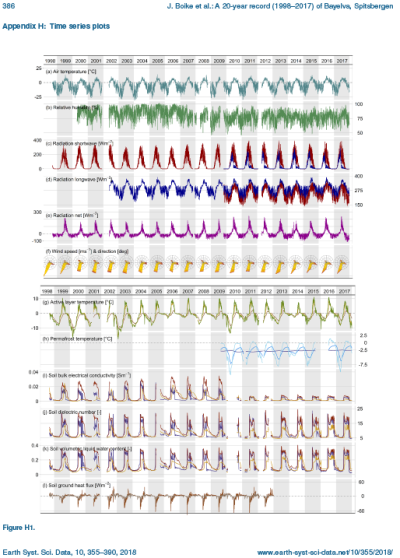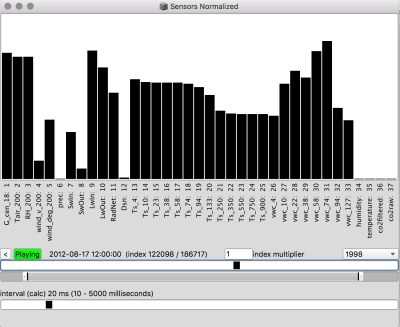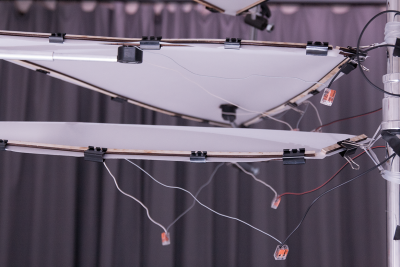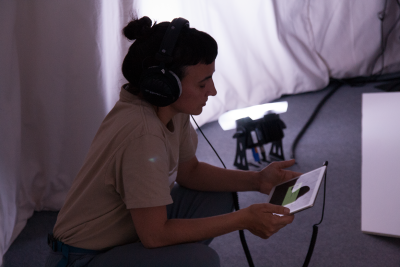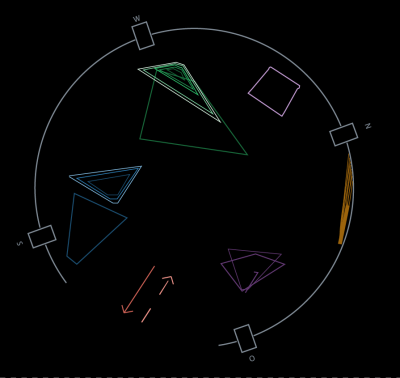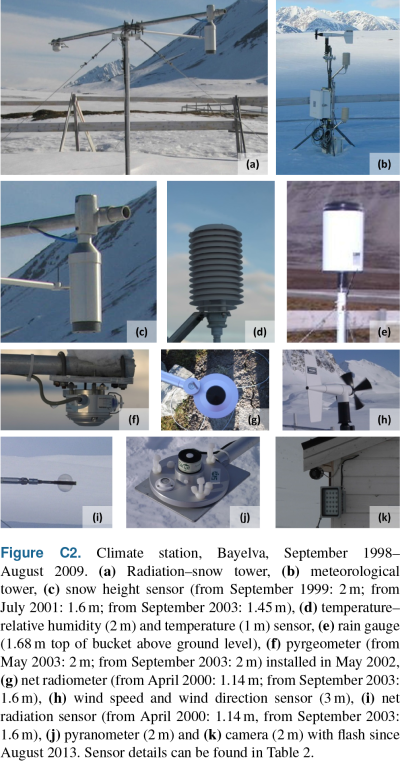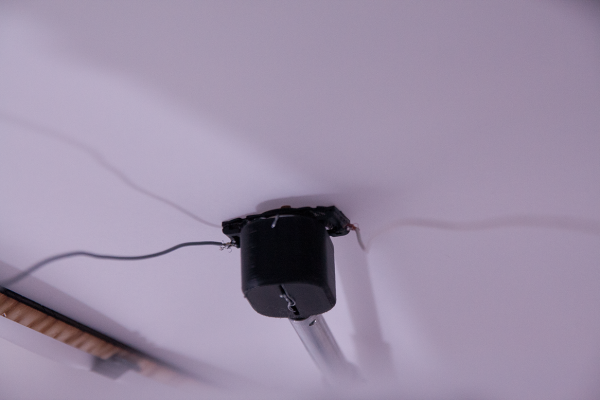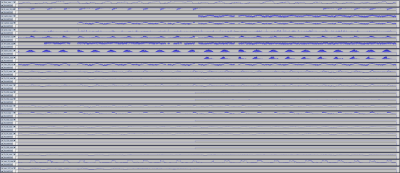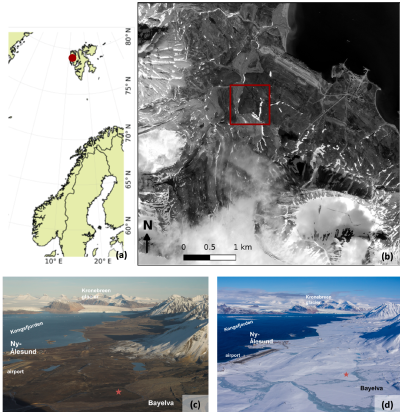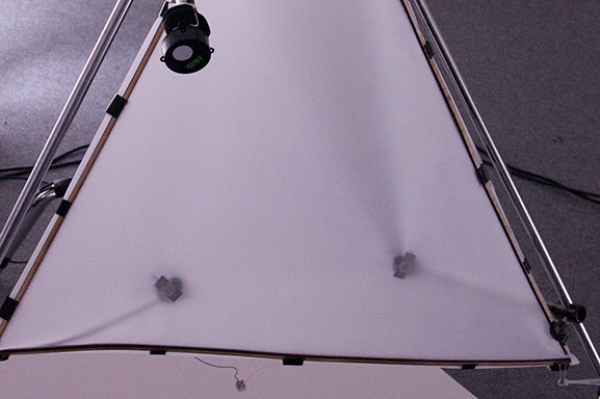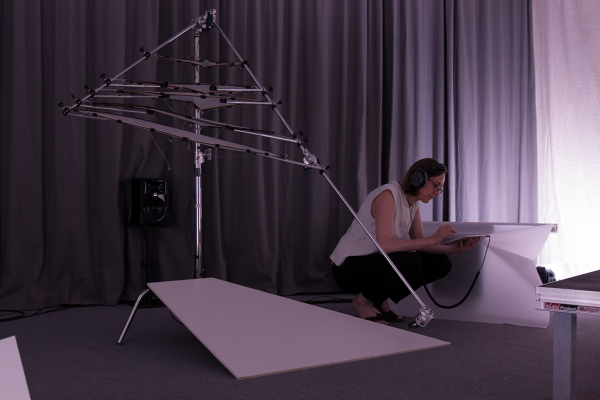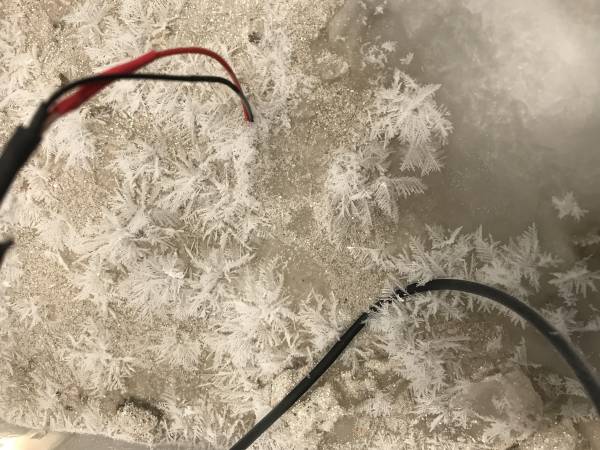By: Sono-Choreographic Collective
Websites:
Kerstin Ergenzinger & Acoustic Ecologies & Sound Studies BUW Weimar
Bnaya Halperin-Kaddari
Kiran Kumar
Tobias Grewenig
Julia Boike research group AWI Potsdam
BAYELVA - Ny-Ålesund Permafrost Observatory
radio.earth - Udo Noll
live-stream BayevaMic
Common Grounds
Common Grounds explores strategies for per-sonifying environmental data and listening to the ecologies of our shared planet. Sustained by profound artistic-scientific exchange this multidisciplinary research asks how a long-term collaboration between climate science and sonic arts practices can be translated into public experiences that communicate and offer embodied, sensorial connections to the fragile complexity of planetary systems.
Climatic changes occur on spatial and temporal scales much larger and slower than those we humans can sensorially perceive. Therefore even in the face of palpable damages to the earth's atmo-, hydro-, cryo-, geo- and biospheres, the climate crisis still remains for many but an inaccessible, looming threat. Drawing on detailed instrumental datasets starting 1998 from the fastest warming place on earth - the circumpolar region of the Arctic, the collective & collaborators develop sonic and choreographic instruments, custom software, listening and storytelling strategies and participatory somatic practices towards realising a constellation of outputs including by now a sonic environment Twenty Springs made of sounding sculptures and stories (more About the installation Twenty Springs), Instrumentalities for Common Grounds a participatory performance in form of a concert-lecture (more About the performance Instrumentalities) and BayelvaMic a permanent live listening station (more About the listening station BayelvaMic).
Initiated by the Sono-Choreographic Collective and Julia Boike, head of Energy- and Water fluxes research group at the Alfred-Wegener-Institut Potsdam to explore strategies for sonifying environmental data, particularly the growing detailed instrumental data sets from the permafrost measurement stations. The data sonification software and methods are developed in collaboration with Tobias Grewenig. The Audio Guide Voice from both Twenty Springs and Instrumentalities for Common Grounds is narrated by Atalya Tirosh and the audio-guide programming is by Moshe Levine.
Link to joint cryospheric science blog post: Perspective on Listening to Permafrost
About the installation Twenty Springs
In Twenty Springs the Sono-Choreographic Collective installs a sonic environment drawing on their artistic-scientific research Common Grounds*. This installation uses a detailed set of hourly environmental data points recorded since 1998 at the Bayelva permafrost measurement station at the Svalbard archipelago in the high arctic region of Norway. Through the custom software developed by the collective in collaboration with Tobias Grewenig, the 33 parameters of the dataset are translated and fed into an array of multi-channel sounding sculptures. Compressed into a single hour, it sonifies the first twenty springs of the current millenium as a navigable, storied, sound-light environment.
This environment establishes an analogous, artificial ecology that maintains an underlying connection to the distribution of sensors installed at the Bayelva research site. The physical-spatial relations of its sound sources stand for the sensors at the arctic station. Spread in space three-dimensionally, they establish relations with the visitors' moving and listening bodies on both horizontal and vertical planes. In addition, a CO2 sensor measures the local atmosphere and includes the effect of the visitors’ breath, incorporating the installation space and the visitors into the sounding data stream.
Bringing together distributed and localized sound sources, electro-acoustic techniques are used, mainly of sound transduction onto layers of tensed paper membranes and foam boards. They are excited by self-developed instruments made of transducer units: bone-conductors, exciters and bass shakers and are joined by one active subwoofer, a ring of near-field audio-monitors and DMX controlled ambient lights.
Operating at different scales, other spatial and musical mappings are at play in Twenty Springs. The data stream of each sensor is modulating the wavetable positions and filters of a synthesized tone. The local CO2 sensor's data stream is the only one that modulates not a synthesized sound but recordings of freezing and melting processes taken in the geophysical lab of the permafrost research group. When all these voices are joined together, the installation sounds as a fluctuating chord whose tones are also mapped to the relative position of the sensors within the station: High pitched sounds are mapped to the changing conditions of the air, lower ones play the layered ground(s) and the bass sonifies the underground. In addition, this drone’s tuning is heard as a very slow rise: Climbing 192 cents during the sixty minutes loop, it is the sounding analogy to the measured 1.92°C mean temperature rise at the Bayelva site in the last 20 years.
Joining the sounds, in order to better navigate the spectrum of active agents and possible perspectives within this environment, other orientation mechanisms assist the visitors. A visual ‘time anchor’ aids the orientation by connecting the polar day-night rhythm, manifesting in the arctic as a one long ‘polar day’ and one long ‘polar night’ through every solar year, the ambient light intensities correspond to the sun’s position within the dataset. Finally, an interactive map of the space, connected to a narrative audio-guide is offered to the visitors. Sonifying climate data through storytelling and narration, this guide helps to establish a common ground for listening, using headphones in order to better personally connect on the move with the environmental soundscape. Taking the form of short stories told through the perspective of each of the station's sensors, they per-sonify these objects and provide the visitors with important factual and affective entry points into the experience.
About the performance Instrumentalities
Instrumentalities for Common Grounds is a participatory performance that collectively tunes into sonifications of environmental data, scaling 20 years of hourly arctic measurements into 60 minutes. In this immersive performance-lecture the Sono-Choreographic Collective shares methods developed for listening, sensing, understanding and connecting to climate change from an embodied perspective. During the performance, participants are guided through various sonic and somatic techniques that tie the planetary scales with individual and collective sensory scales. The performance unfolds around a table that is a hybrid surface for discourse, policy, strategy, negotiation, communication and communion.
Excerpt, performance script:
“Our bodies are here and now, around a table, at a conference, political parties, environmental conventions; surfaces upon which decisions could be made, and matters could be taken into hands. And the matter on this table is the changing global climate. These changes are mostly invisible to us here, yet by listening to another year passing in our sonification, these changes become audible.
The scaling of the twenty years into sixty minutes; the scaling of that remote, fenced measurement station out there in the far north onto this table surface here.
These scalings allow us to sense a macro-global phenomena and to be affected by it, in our meso-local being, in our here and now, and in our whole undivided soma.”
Instrumentalities for Common Grounds - Trailer
About the listening station BayelvaMic
BayelvaMic is a permanent listening station realised in collaboration with and through the participatory radio.earth project by Udo Noll that focuses on the ecological crisis, its impact on the environment, and potential courses of action.
Link:live-stream BayevaMic
radio.earth aims to establish a collaborative network between individuals and organisations interested in these subjects and their respective practices, ranging from art and science to activism. To increase knowledge and awareness of changing natural conditions, the shared radio.earth listening streams encourage critical listening to live soundscapes from natural environments, curated by its participants. This collaboration with radio.earth is also part of the chair of Acoustic Ecologies at Bauhaus-University Weimar.
Vertebrae of Common Grounds
An annotated Glossary
As a way of communicating our process and findings, this glossary presents key concepts and terms we encountered through our work, bringing together scientific, as well as artistic voices.
Its main scientific sources are the IPCC Glossery from the Special Report: Global Warming of 1.5 ºC, marked by a ° sign 1), and a scientific article by Prof.Dr.Julia Boike and the permafrost research group on Energy and Waterfluxes, marked by a ∆ sign 2).
The annotations to some of the entries are mostly by Kerstin Ergenzinger and Bnaya Halperin-Kaddari and are marked by a ^ sign.
Other sources are marked by a * sign together with their name.
Active Layer
The upper surface layer of seasonally freezing and thawing ground is called the Active Layer. The range in temperatures and water and ice content of this active, upper surface layer of seasonally freezing and thawing ground determines the biological and hydrological processes that operate in these areas. ∆
| Active Layer, skin of a frozen body |
|---|
The fragilely frozen body of this ground is covered and protected by an active epidermis. The skins’ layers absorb and store the energy of the warming atmosphere. Thawing and refreezing it is not only continuously changing its structure and potential properties (see Volumetric Liquid Water Content) but also slowly expanding in depth. Shifting the zero line of the permanent freeze. Inside the sono-choreographic test site of Common Grounds, which is an experiential, immersive model of the Bayelva research site, the active layer is present in the form of an 1 ½ m high tripod tower. It gives place to 5 layers of tensed tracing paper membranes that are put in motion by a chain of exciters transducing the sonified frequencies of the soil temperature measurements in different depth and their connected volumetric water content records. The layering mimics the spatial relation of the probed soil profile placed inside the arctic ground. The paper membranes amplify and filter the sonified data stream and give rise to a highly localizable and fragile sonic presence. The top and the 6th layer out of foam board at the base of this sonic sensor tower represents and gives voice to the connected snow depth. ^
Adaptation
In human systems, the process of adjustment to actual or expected climate and its effects, in order to moderate harm or exploit beneficial opportunities. In natural systems, the process of adjustment to actual climate and its effects; human intervention may facilitate adjustment to expected climate and its effects.°
| Adaptation across scales and depths |
|---|
In the more than human systems that we are, that we are embedded in, we constantly adapt. Our gut microbiome adapts to recent food intake, our genes to the changing environment, perhaps even to our life experiences. How apt are we to plan deeper adaptations to effects on scales we cannot sense? To what extent will these adaptation processes change who we are and how we run things? Will sensing the scale of change motivate us to adapt better? Faster? Stronger? ^.
Albedo
The fraction of solar radiation reflected by a surface or object, often expressed as a percentage. Snow-covered surfaces have a high albedo, the surface albedo of soils ranges from high to low, and vegetation-covered surfaces and the oceans have a low albedo. The Earth’s planetary albedo changes mainly through varying cloudiness and changes in snow, ice, leaf area and land cover. See also energy balance.°
| Albedo in the high Arctic area of the Bayelva research station |
|---|
The West Spitsbergen Current, a branch of the North Atlantic, warms this area to an average air temperature of between 17.0 and 3.8 C in January, and from 4.6 to 6.9 C in July (18-year period: 1 August 1993 to 31 July 2011; Maturilli et al., 2013). It also provides about 400 mm of precipitation annually, which falls mostly as snow between September and May…The seasonal snow cover in Arctic permafrost regions insulates the permafrost surface for many months of the year and has an important effect on the thermal regime of permafrost…Changes in the duration and quality of the snow cover are changing the albedo and its energy balance, the relationship between incoming solar radiation, outgoing radiation of all types, and temperature change ∆.
Arctic
The regions north of the arctic circle currently beyond N 66°33′49.0″. * Regions with permanently frozen ground are located further north in the high Arctics between N 70 - 80°. ^ The Bayelva research site at the west coast of the Svalbard archipelago is located at N 78°92’02’’. Another site maintained by AWI is on, Samoylov Island at N 72°22’ Ω.
* Wikipedia
Ω Permafrost research website operated from Alfred-Wegener-Institut Potsdam
See also Bayelva
Atmosphere
The gaseous envelope surrounding the earth, divided into five layers – the troposphere which contains half of the Earth’s atmosphere, the stratosphere, the mesosphere, the thermosphere, and the exosphere, which is the outer limit of the atmosphere. The dry atmosphere consists almost entirely of nitrogen (78.1% volume mixing ratio) and oxygen (20.9% volume mixing ratio), together with a number of trace gases, such as argon (0.93 % volume mixing ratio), helium and radiatively active greenhouse gases (GHGs) such as carbon dioxide (CO2) (0.04% volume mixing ratio) and ozone (O3). In addition, the atmosphere contains the GHG water vapour (H2O), whose amounts are highly variable but typically around 1% volume mixing ratio. The atmosphere also contains clouds and aerosols. °
| Concepts of Atmosphere |
|---|
…But if, for the meteorologists, the atmosphere belongs to the world of insentient nature, for the aestheticians it was placed unequivocally on the side of human consciousness with its feelings, sensations and perceptions. Thus the two atmospheres, of meteorology and aesthetics, straddle the familiar divisions between nature and humanity, materiality and sensoriality, the cosmic and the affective…*
* Ingold, Tim. 2015. The life of lines.
Arts & Science
Whether a pedagogical category, a funding scheme or, at best, a transdisciplinary methodology, art and science dance around notions of action and interpretation. Making art in relation to making science opens a plethora of questions regarding the approaches, strategies, techniques and practices under each of these paradigms. And especially at their contact point, where the empirical meets the speculative, we are faced with the gaps of terminology, prior knowledge and expertise (or lack of). Coming as artists to this conversation we bring our hearts and minds poised to be open yet critical, intuitive yet thorough, curious and imaginative. But in order for the magpie to dance with the raven they must agree on rules of the game. Hence, what began in 'Common Grounds' as a given task to sonify a data set, grew up to encompass an investigation into what this meeting could even be? As it surely means more than the raven putting on a white lab coat and making nice artworks based on visits to the magpie's lab, there is an invitation here for a more profound interaction and exchange. One that reflects on our own artist’s patterns, omissions and deaf spots, and in turns critiques and asks about the fundamentals of science making ^.
Bayelva
A research site at the west coast of the Svalbard archipelago, located at N 78°55’24’’ and operated from the Permafrost research group of Julia Boike at Alfred-Wegener-Institut Potsdam. The detailed record of hourly environmental data since 1998 serves as a base for Common Grounds' tangible sonification research and experiments^.
Bone Conductor
A small speaker element consisting of a magnet and coiled metal wire that is able to translate electrical signal into acoustic vibration without a membrane. These speaker elements that put attached material in motion and transform them into resonating and amplifying membranes and bodies are also called transducers or exciters. A bone conductor is often used in motorcycle helmets or other environments where sound should not be propagated through the air, but rather through a solid medium. Our bone conductors are connected to custom made mounts and are passing their vibration to stretched sheets of tracing paper, giving the emitted sound a somewhat 'papery' feeling^.
See also Paper
Carbon cycle
The term used to describe the flow of carbon (in various forms, e.g., as carbon dioxide (CO2), carbon in biomass, and carbon dissolved in the ocean as carbonate and bicarbonate) through the atmosphere, hydrosphere, terrestrial and marine biosphere and lithosphere. In this report, the reference unit for the global carbon cycle is GtCO2 or GtC (Gigatonne of carbon = 1 GtC = 1015 grams of carbon. This corresponds to 3.667 GtCO2) °.
(organic) Carbon (frozen)
Most permafrost is located in the Arctic, where frozen organic carbon makes it an important component of the global climate system. Despite the fact that the Arctic climate changes much more rapidly than the rest of the globe, observational data density in the region is low. Permafrost thaw and carbon release to the atmosphere are a positive feedback mechanism that can exacerbate global warming. This positive feedback functions via changing land–atmosphere energy and mass exchanges ∆.
See also Permafrost
Climate
Climate in a narrow sense is usually defined as the average weather, or more rigorously, as the statistical description in terms of the mean and variability of relevant quantities over a period of time ranging from months to thousands or millions of years. The classical period for averaging these variables is 30 years, as defined by the World Meteorological Organization. The relevant quantities are most often surface variables such as temperature, precipitation and wind. Climate in a wider sense is the state, including a statistical description, of the climate system.°Condition of the atmosphere at a particular location over a long period of time (from one month to many millions of years, but generally 30 years). Climate is the sum of atmospheric elements (and their variations): solar radiation, temperature, humidity, clouds and precipitation (type, frequency, and amount), atmospheric pressure, and wind (speed and direction). To the nonspecialist, climate means expected or habitual weather at a particular place and time of year. To the specialist, climate also denotes the degree of variability of weather, and it includes not only the atmosphere but also the hydrosphere, lithosphere, biosphere, and such extraterrestrial factors as the sun*.
* Britannica
See also Weather
Climate Change
Climate change refers to a change in the state of the climate that can be identified (e.g., by using statistical tests) by changes in the mean and/or the variability of its properties and that persists for an extended period, typically decades or longer. Climate change may be due to natural internal processes or external forcings such as modulations of the solar cycles, volcanic eruptions and persistent anthropogenic changes in the composition of the atmosphere or in land use. Note that the Framework Convention on Climate Change (UNFCCC), in its Article 1, defines climate change as: ‘a change of climate which is attributed directly or indirectly to human activity that alters the composition of the global atmosphere and which is in addition to natural climate variability observed over comparable time periods.’ The UNFCCC thus makes a distinction between climate change attributable to human activities altering the atmospheric composition and climate variability attributable to natural causes°.
| How to form a relation to the changing climate? |
|---|
Even after decades of awareness, the topic of climate change still remains difficult to engage with or talk about. Taking place on a spatial and temporal scale much larger and slower than our human perception, it is for many just an inaccessible, looming threat. One needs to make an emotional leap and willingness to think quite abstractly in order to truly connect with it as a phenomenon. Perhaps it is so because the thing we call climate lies beyond our perceptual scale. And yet it is a very real thing. Scientists study it and construct models that try to anticipate its behavior, but eventually we all can only actually perceive the present weather. Hence, maintaining a relation with the climate must rely on our imagination. If climate is what we anticipate and weather is what we perceive, we could view the climate as accumulative behavior of lots and lots of weather. Perhaps a good starting point for such leaps could be a sincere acknowledgement of the ways in which we are embedded in the weather. With its elements to which we expose or protect ourselves from, weather affects and shapes us, in every aspect of our lives, in every single moment. Everywhere and all the time. How hot is it right now? How humid? How clogged is your nose? How moist your skin? Listen to the constant exchanges between yourself and your surroundings. Imagining begins with observing that begins with attention. It is probably true for any relation, in any size and speed ^.
See also Scale
Common Grounds
It is the common that we want to address - as a society, as a polis, as demos plural, as what is still left from the ideas of global citizens and as members to the species that must move away from the center of the stage if it wishes to survive as a civilisation. This common refers also to the commonality shared between artistic and scientific ways of engaging with the world. Working with time based media that foregrounds sound, our offering hopes to be a welcoming host, a gastgeber to all, initiated specialists and non-specialists alike ^.
Data
1. Factual information (such as measurements or statistics) used as a basis for reasoning, discussion, or calculation.
2. Information in digital form that can be transmitted or processed
3. Information output by a sensing device or organ that includes both useful and irrelevant or redundant information and must be processed to be meaningful *
* Merriam-Webster
See also True to data
Digital Instrument
Under construction ^
Ecosystem
An ecosystem is a functional unit consisting of living organisms, their non-living environment and the interactions within and between them. The components included in a given ecosystem and its spatial boundaries depend on the purpose for which the ecosystem is defined: in some cases they are relatively sharp, while in others they are diffuse. Ecosystem boundaries can change over time. Ecosystems are nested within other ecosystems and their scale can range from very small to the entire biosphere. In the current era, most ecosystems either contain people as key organisms, or are influenced by the effects of human activities in their environment °.
… ecology is in here and not out there… ^
Earth Energy Balance
The relationship between incoming solar radiation, outgoing radiation of all types, and global temperature change ∆.
The balance between incoming, stored, transformed and outgoing energy. All incoming energy of our habitat earth is solar energy. This solar radiation is shortwave radiation. Ultimately, all of outgoing energy is radiated in the form of longwave radiation back into space ^.
Frequency
Under construction ^
Global Warming
The estimated increase in global mean surface temperature (GMST) averaged over a 30-year period, or the 30-year period centered on a particular year or decade, expressed relative to pre-industrial levels unless otherwise specified. For 30-year periods that span past and future years, the current multi-decadal warming trend is assumed to continue °.
See also Climate Change
| Arctic warming |
|---|
Under construction ^
Listening
under construction ^
Mapping
under construction ^
Model
under construction ^
Narratives Qualitative
Descriptions of plausible future world evolutions, describing the characteristics, general logic and developments underlying a particular quantitative set of scenarios. Narratives are also referred to in the literature as ‘storylines’ °.
| Storytelling |
|---|
…is always under construction… ^
Noise
under construction ^
Paper
under construction ^
Permafrost Ground
Soil or rock and included ice and organic material that remains at or below 0°C for at least two consecutive years°.
Defined as ground that has remained frozen continuously for 2 years or more ∆.
Polar Night and Day
under construction ^
Polyphony
Polyphony is a type of musical texture consisting of two or more simultaneous lines of independent melody, as opposed to a musical texture with just one voice, monophony, or a texture with one dominant melodic voice accompanied by chords, homophony. *
| Polyphonic Practice |
|---|
Unlike in seeing, while listening we can maintain the individuality of the lines even when several of them are heard simultaneously. In music such a texture is called polyphonic, and we think it is a very appropriate sounding tactic to think through and about multi-dimensional data. Furthermore, musically polyphonic textures could be listened to as a metaphor for life in ecosystems – different voices coexist and fuse while keeping their individuality, creating a unified whole that is inherently difficult to control. Here lies the fundamental connection to the urgency of the climate crisis. As climate is a phenomenon that is not operating at human scale, the intangibility of the planetary scale is a main human problem that prevents us from adequately addressing it – we are simply not sensing how urgent it is. ^
* Wikipedia
Radiation
under construction ^
Rain
under construction ^
Scale
under construction ^
Sensor
under construction ^
Signal
under construction ^
Sono-Choreography
under construction ^
Snow Cover
under construction ^
Soil Moisture
Water stored in the soil in liquid or frozen form. Root- zone soil moisture is of most relevance for plant activity. °
Sonification
Sonification is the use of non-speech audio to convey information or perceptualize data. Auditory perception has advantages in temporal, spatial, amplitude, and frequency resolution that open possibilities as an alternative or complement to visualization techniques. *
| How can we can learn through the ears about the interdependencies of the atmosphere and the geosphere? How can we translate what we learn into an experience that offers an embodied, sensorial connection to the fragile complexity of these planetary systems? |
|---|
The main task for us with the detailled Bayelva data set is to compress time but still keep it intelligible. Sonifying long durations as a one-to-one relation is possible but not very informative as it scales out of our human time perception. When temporal data is sonified in a different time scale than the one it was recorded in it becomes an abstraction, a behavior which can modulate a carrier sound and is much more listenable.
Our chosen methods includes interpretation, calibration and tuning in order to continuously address the tension between our wish to stay ‘true to the data’ and the need to mediate it through the audio sensory perception.
Listening and experimentation sessions with different sound synthesis lead us to the use of wavetable synthesis, where the timbre of a carrier sound, its wavetable position, filters etc., is being modulated by the data. The data stream of each sensor is modulating a tone, emitted through sound sculptures spreaded in space in an analogy to the position of the sensors in the modeled scientific station.
When combined the installation sounds as a fluctuating chord, whose tuning is heard as a very slow rise: climbing 192 cents during the sixty minutes loop, analogous to the measured 1.92°c mean temperature rise at the site in the last 20 years. ˆ
Sounding
'Sounding' out the grounds, rather than seeing, because as the world is fully mapped optically and we are saturated with tyrannic imagery, it is the sonic spectrum that is still available, allowing us to make-felt the planetary scale we address. The scale of the ear is larger than that of the eye and speakers are larger than screens. ^
Speaker
under construction ^
Spectrum
under construction ^
Svalbard Archipelago
Svalbard, also known as Spitsbergen, or Spitzbergen, is a Norwegian archipelago in the Arctic Ocean. North of mainland Europe, it is about midway between the northern coast of Norway and the North Pole. The islands of the group range from 74° to 81° north latitude, and from 10° to 35° east longitude. The largest island is Spitsbergen, followed by Nordaustlandet and Edgeøya. The largest settlement is Longyearbyen.*
* Wikipedia
Transformation
A change in the fundamental attributes of natural and human systems. °
| A change could be heard |
|---|
under construction ^
Transition
The process of changing from one state or condition to another in a given period of time. Transition can be in individuals, firms, cities, regions and nations, and can be based on incremental or transformative change. °
True to Data
under construction ^
Tuning(s)
under construction ^
Uncertainty
A state of incomplete knowledge that can result from a lack of information or from disagreement about what is known or even knowable. It may have many types of sources, from imprecision in the data to ambiguously defined concepts or terminology, incomplete understanding of critical processes, or uncertain projections of human behaviour. Uncertainty can therefore be represented by quantitative measures (e.g., a probability density function) or by qualitative statements (e.g., rejecting the judgment of a team of experts) (see Moss and Schneider, 2000; IPCC, 2004; Mastrandrea et al., 2010) °.
See also Adaptation
Visualisation
under construction ^
Volumetric Liquid Water Content (VWC)
under construction ^
Vulnerability
The propensity or predisposition to be adversely affected. Vulnerability encompasses a variety of concepts and elements including sensitivity or susceptibility to harm and lack of capacity to cope and adapt°.
Witnessing
How could we become witnesses of abstract and remote phenomena that affect and transform the foundations of life but are beyond the scales of our human perception ? How can we connect and both emotionally and analytically transgress the distance we keep ? See also scale, adaptation ^
Transition
The process of changing from one state or condition to another in a given period of time. Transition can be in individuals, firms, cities, regions and nations, and can be based on incremental or transformative change. °
Weather
State of the atmosphere at a particular place during a short period of time. It involves day-to-day changes in such atmospheric phenomena as temperature, humidity, precipitation (type and amount), air pressure, wind, and cloud cover. Most weather occurs in the troposphere, but phenomena of the higher regions of the atmosphere, such as jet streams, and geographic features, most notably mountains and large bodies of water, also affect it*.
* Britannica.
See also Climate
Well-Being
A state of existence that fuels various human needs, including material living conditions and quality of life, as well as the ability to pursue one’s goals, to thrive, and feel satisfied with one’s life. Ecosystem well-being refers to the ability of ecosystems to maintain their diversity and quality. °
| Listening |
|---|
Listening is worlding and being embedded in the world, sympathetically resonating with it.
Making it and being made by it in every oscillating cycle ^.
To be Continued...
Meanwhile, for more info or inquiries, please write us at
bnaya.hk 'at' gmail.com
or
kerstin.ergenzinger 'at' nodegree.de
Support
Up to now Common Grounds has been supported by The Academy for Theater and Digitality , HIDA - Helmholtz Information & Data Science Academy, Alfred-Wegener-Institut Helmholtz Centre for Polar and Marine Research, the Malmö City Cultural Council and the Sound Environment Center at Lund University.
